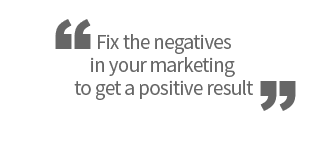Marketing is broken. Well, bits of it. It’s important to check and fix errors and bad decisions. Pull in for an occasional pitstop and improve your B2B lead generation.
Like a Formula 1 Pitstop Crew, you can fix and boost your performance quickly if you know where to look. Here are my 5 suggestions to get you firing on all cylinders.
1. Here is how you fix low traffic from social media
This is easy. Don’t fixate on social media, it’s a losing battle (especially B2B).
On average, only 6.44% of traffic to your website will come from social platforms (and the Bounce Rate can be alarmingly high). Truth is, you will always get low traffic.

Add to that some research from Harvard Business Review that showed Likes and Follows on social media has little impact on buying behaviour, and you may conclude that your time/budget is better spent elsewhere.
Where social platforms, such as LinkedIn, do become a useful B2B lead generation tool is in research. Great for the sales team to identify the buying team, great for the marketing team to confirm job titles, name spelling etc.
(Also, Twitter is a useful platform for opinion polls. Very cost-effective way to get stats for content marketing, which helps B2B lead generation).
2. Here is how you fix a high bounce rate on your website
Check your bounce rate in Google Analytics, it will never be zero but 25% is a good figure.
One of the easiest ways to reduce bounce is to exclude visits from your staff. Their visits corrupt your stats and inflate the bounce rate.
Get the IP Addresses of your staff (and suppliers?) then go to the Admin section in Google Analytics and add them to the ‘Filters’ page.
Concentrate your efforts on those channels that typically have a low bounce rate, such as organic search and referral. Google Ads (Display), Paid Search and Social tend to have high bounce rates so beware.
The purpose of reducing bounce is to drive more relevant traffic to your site – people that are genuinely interested in your product/service – which reduces waste and improves ROI. You get better quality leads if you reduce bounce.
Obviously, having fresh and original content on your website will also reduce bounce, as well as improving the time spent on the site, the number of pages viewed and encourage repeat visits.
3. Here is how to improve ROI on Google Ads
Test, test and test again. Different headlines, different body text and different landing pages. Try new keywords, but based on the search terms your audience use and not your personal preference (and include the search terms in your advert).
Google Ads will help you with suggestions, make sure you incorporate them.
But be realistic. The majority of advertisers get a click rate of 5% or less on Google Ads. Plug that into your marketing forecast and see if it makes sense.
A fatal mistake I often see is that a promise made in the advert is not delivered on the landing page. If your advert states your new software reduces energy bills by 40%, make that the headline of your landing page and expand on only that offer. Don’t distract the visitor by explaining how you also offer other services. Focus.
In my opinion, Google Ads are great for remarketing. Not everybody that visits your site will be ready to buy. Google Ads can ensure your name remains front of mind for your website visitors – ensuring so they don’t forget you when they make a purchasing decision.
More information at About Remarketing – Google Ads.
4. Here is how you fix false positives on email campaigns
Check the time. Quite simply, if the open/click time is a few milliseconds after your email campaign was sent, it was done by a security bot, not a human. No human could respond that quickly.
These security bots are more widely used, especially by large organisations, and they are giving artificially high open and click rates. Don’t be fooled.
The fix is to check the time before you add the open or click to your CRM, or pass it to your sales team for follow-up.
If we are talking small numbers, it can be done using a formula in Excel to identify the ‘human’ interaction (or just eye-ball the data). If we are talking massive numbers, you need to talk with your email platform provider or CRM provider about excluding the security bots. Sometimes your IT/Data department can provide a solution.
5. Here is how you improve the quality of your data
Good data is often related to quantity. Ask a CEO if they have great prospect data and they may reply “Yes, we have x thousand names in our CRM”. But they have never checked how many of those data records are accurate or useful.
Honestly, this is not a quick fix. But great prospect data is so important I had to include it.
You start by getting your C-level executives to evangelise about data. Without their support and enthusiasm for quality data, you are screwed. Try and put a value on your prospect data, that will help.
Or ask them what would happen if all their prospect data was deleted/stolen/hacked. Data is valuable, quality data is very valuable.
Then you create a training programme for all those that enter data in your CRM (especially the sales team). And you repeat that training programme every year – don’t assume they will remember what you taught them 12 months ago.
Include in your training some education about data laws and the real fines that are being issued for failure to comply.
When it comes to checking the data for errors, I prefer to eyeball the data in Excel – it just makes it easier to spot the errors and you can use formulas to do some of the hard work.
Finally, recognise that some salespeople may be dyslexic. They are persuasive talkers, but not so great at spelling. Use drop-down menus and tick boxes as much as possible in your CRM to limit the keystrokes.
Conclusion
Fix the negatives in your marketing to get a positive result.
Marketing people are trained to see the positives in products and services. It’s our job. But wearing rose-coloured spectacles can mean we fail to see errors and bad decisions.
What have been my errors and bad decisions? Getting swept along with the hype surrounding social media. I’m determined to be more realistic about its value. Also, not putting enough effort into increasing my Google Ads response from 2% to the average 5% – especially on remarketing.
What are your errors and bad decisions and how do you plan to fix them? Let me know if I can help, book a free 1-hour consultation.
| Marketing Graham Bulletin |
|---|
